Term 3 Chapter 3 | 6th Maths - Area | 6th Maths : Term 3 Unit 3 : Perimeter and Area
Chapter: 6th Maths : Term 3 Unit 3 : Perimeter and Area
Area
Area
Recall the ‘Apoorva and her biscuits arrangement’
in the beginning of this chapter. We do not know the measure of the side of the
biscuit. But we know it is in the shape of a square. Let its side be 1 unit. The
tray can hold 12 square biscuits (square units). That is, 12 square biscuits (square
units) occupy the entire surface of the tray. This space of the tray is called the
Area of the tray.
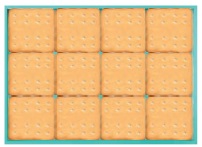
Thus, the area of any closed shape is the surface
occupied by the number of unit squares within its boundary. Suppose each side of
a biscuit is of 1 inch length, then the
area of the tray is 12 square inches.
1.
Area of a Rectangle
As the above tray is in the shape of a rectangle,
split it into small and uniform squares called unit squares. There are 4 unit squares
along its length and 3 unit squares along its breadth. Totally, 12 square biscuits
occupy this rectangle and so the area of this rectangle is 12 square units.
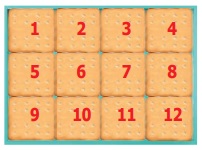
Suresh brought a groundnut burfi packet to school
as snacks to eat during the break. As he peeled off the cover, he saw that there
are 3 rows and each row has 5 square pieces. What he sees here is that the total
number of small squares in the given burfi is 15. So, the area of the given rectangular
burfi is 15 square burfi pieces.
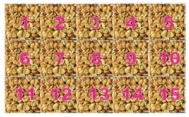
Tamizhazhagi wants to share a chocolate bar with
her friends on her birthday. The chocolate bar that she has bought has 5 square
pieces horizontally and 4 square pieces vertically. She finds that there are 20
identical unit square chocolate pieces so that she can give it to 19 of her friends
and have 1 for herself.
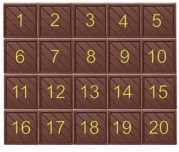
Here, the total number of square chocolate pieces
is 20, which represents the area of the whole chocolate bar.
The total number of squares in all these cases can
be Note arrived by multiplying the number of squares along its length with the number
of squares along its breadth instead of counting them.
Therefore the area of any rectangle = (length ×
breadth) square units.
= (l × b) sq.
units.
Note
‘Square units’ can also be written
as ‘unit2’.
Try these
Find the number of tiles required
to fill the area of following figures.

Example 9
Find the area of a rectangle of length 12 cm and breadth 7 cm.
Solution
Length of the rectangle, l = 12
Breadth of the rectangle, b = 7
Area of the rectangle A = (l × b) sq. units.
= 12 × 7 = 84 sq. cm.
2.
Area of a Square
If the length and breadth of a rectangle are equal,
then it becomes a square.
Area of the rectangle = (length × breadth) square
units.
= (side × side)
sq. units.
= (s ×
s) sq. units.
= Area of a square
Therefore area of a square = (s × s)
sq. units.
When the rectangle is made into a
square then length (l) = breadth
(b) = side (s)
Example 10
Find the area of a square of side 15 cm.
Solution
Side of the square, s = 15 cm
Area of the square, A = (s × s) sq. units.
= 15 × 15
= 225 sq. cm. (or) 225 cm2
3.
Area of a Right Angled Triangle
In a right angled triangle one of the sides containing
the right angle is treated as its base (b units) and the other side as its height (h units).
When a rectangular sheet is cut along its diagonal,
two right angled triangles are obtained.
Area of two right angled triangles = Area of the
rectangle
2 × Area of a right angled triangle = l ×
b
Area of the right angled triangle = 1/2 (l ×
b)
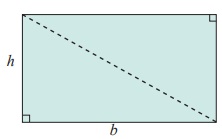
The length and breadth of the rectangle are respectively
the base (b) and height (h) of the right angled triangle.
Hence, area of the right angled triangle = 1/2 (b
× h) sq.units.
Activity
Mark the base and height of the following
right angled triangles.

Example 11
Find the
area of a right angled triangle whose base is 18 cm and height is 12 cm.
Solution
Base, b = 18 cm
Height, h
= 12 cm
Area, A =
1/2 (b × h) sq units
= 1 / 2 (18 × 12)
= 108 sq. cm. (or) 108 cm2
Try these
Draw the following in a graph sheet.
i) Two different rectangles whose
areas are 16 cm2 each.
ii) A shape with perimeter 14 cm and area 12 square cm.
iii) A shape with area 36 square cm.
iv) Form different shapes using 4
unit squares and find their perimeter and area. (Sides of the squares must fit exactly)

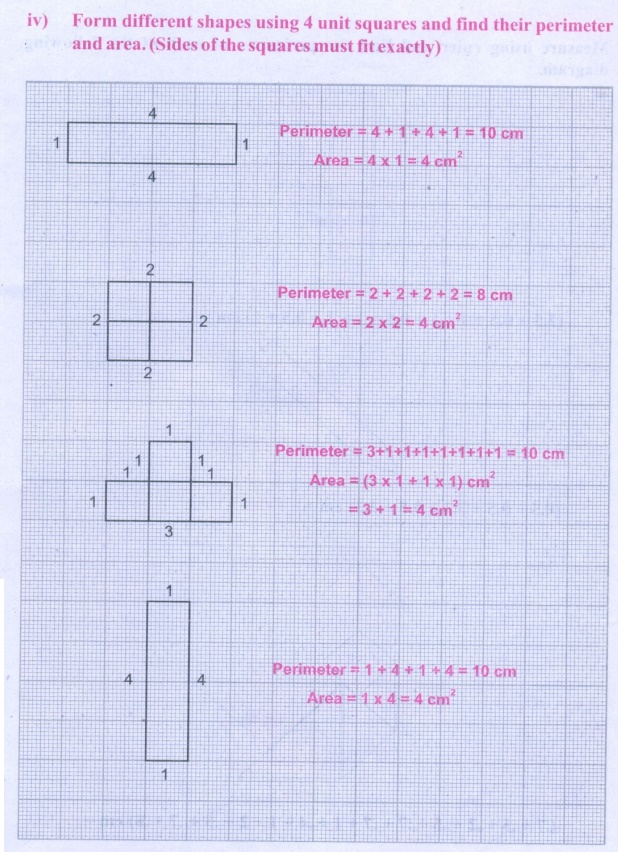
Related Topics